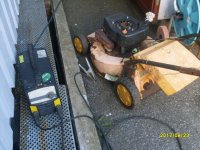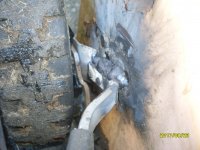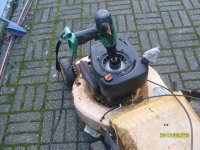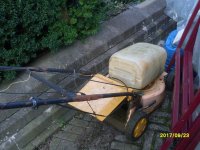Dissappointing news for now: There's a Sachs Dolmar KMS-4 chainsaw offered on ebay not too far from my home. But 2 k€ 😱😱😱?
Best regards!
Best regards!
Pretty much all P&W R-1690s, with whatever local sauce and improvements. You could also buy copies from Japan or Russia. The R-1690 going back through the Wright Whirlwind really changed aviation. I have rode in a DC-3, a Constellation, the Lockheed you got when the route was not enough for a Connie, and a B-17, and was nearly hit by a Hellcat, all radials. The Connie and Lockheed were regular airliners. The DC-3 was past its prime doing short-hop tourist work. The B-17 was recent, joy-ride work.
Yes, sadly these OS Max RE 49 P I or II model aircraft engines aren't in production anymore. I recall that in my youth they were sold by Graupner here in Gemany. Today you could source NOS ones with some luck, but even used engines in unknown condition are $$$ or €€€.
Best regards!
Best regards!
I always thought that all Connies and Super Connies were powered by 18 cylinder, two row Wright R-3350 »Cyclone« engines?I have rode in a DC-3, a Constellation, the Lockheed you got when the route was not enough for a Connie,
Best regards!
If you read about engine upgrades (Soloy turbine conversion on Bell 47, for example), it got to the point that almost all the airworthy aircraft had engines which were not original.
And turbo prop conversions were also common.
And turbo prop conversions were also common.
That would be fun to watch when it gets stuck in high grass - the drill spinning around until the cord wraps around it…..
Hi 🙂
wg_ski i think you misunderstood, I Only Use The Drill To Start it up, like an electric starter motor, and once it starts in a hurry rip's it off... 🙂
wg_ski i think you misunderstood, I Only Use The Drill To Start it up, like an electric starter motor, and once it starts in a hurry rip's it off... 🙂
Althoug it has happend,
And the wire's from my drill (does'nt have a battery so just use a 12 volt truck battery) snapped so hard over my thigh that i had marks for weeks... 🙂
And the wire's from my drill (does'nt have a battery so just use a 12 volt truck battery) snapped so hard over my thigh that i had marks for weeks... 🙂
"Cyclone" is a trade-name, Wright's were called "Whirlwind", in many sizes.thought that all Connies and Super Connies were powered by 18 cylinder, two row Wright R-3350 »Cyclone« engines?
As the world's finest tri-motor, many variant powerplants were used.
Here's a Connie with turbo-props (must sound weird):
https://upload.wikimedia.org/wikipe...d_R7V-2_turboprop_Connie_in_flight_c1953.jpeg
https://en.wikipedia.org/wiki/List_of_Lockheed_Constellation_variants
To my big surprise, most older (Lockheed C-130 e.g.) turboprop powered aircrafts' sound strongly resemble piston engines. I'm always wondering why they're that loud.
Best regards!
Best regards!
Gasoline engines were not noisy, it was the propellers, now the new scimitar shaped ones may be less noisy.
Of course planes did not have much by way of mufflers either.
It is a function of tip vortex turbulence and velocity...scimitars have 6 in place of 4 blades, and are smaller in diameter on the same aircraft.
As an aside, the tail rotor on the Mi-26 is 20 feet diameter, same as the propeller on An-32 transport...
Of course planes did not have much by way of mufflers either.
It is a function of tip vortex turbulence and velocity...scimitars have 6 in place of 4 blades, and are smaller in diameter on the same aircraft.
As an aside, the tail rotor on the Mi-26 is 20 feet diameter, same as the propeller on An-32 transport...
The Wright R-3550 engine that flew aboard the Lockheed Constellation was the pinnacle of piston-engines, as such, the maintenance on them was horrific. One of the key aspects that rendered jet-engine powered airliners superior was their engine maintenance schedules. A lore that went around was one of the first airliner engine services had crews pulling engines apart expecting to see wear patterns requiring replacements...after some 2000Hrs or so, these engines were buttoned back up & sent back into service, the powers that be scratching their heads & totally rethinking service intervals.
.................................................................................................................Rick...
.................................................................................................................Rick...
How come the Wright R-3550 engine was so difficult to maintain, wheras the DC3 ( same engine technology) had the reputation of a very dependable and easy to maintain aircraft.
The DC3 has been widely used all over the world and in the middle of nowhere for a very long time.
I flew on a DC3 several times between Paris and Brittany in the early 70s until it was replaced by a Fokker a twin turbo prop airplane.
The DC3 has been widely used all over the world and in the middle of nowhere for a very long time.
I flew on a DC3 several times between Paris and Brittany in the early 70s until it was replaced by a Fokker a twin turbo prop airplane.
Piston engines with poor air filters had service lives in hundreds of hours, particularly sleeve valve types.
And a piston engine overhaul means a bore / crank / full rebuild.
After that, those with experience of setting up a V8 with four carbs and two sets of points will tell you how maddening it was, and how quickly they seem to go out of tune.
Extend that to 18 cylinders...all to be tuned perfectly.
Fuel consumption is higher, and power to weight less than that of a turbine engine.
Another aspect was that after the war, lots of perfectly airworthy aircraft were removed from service, and most were scrapped.
There were no engines or parts being made, so what did you do when you needed to keep the plane flying?
Put a lighter, more powerful engine, less maintenance, lower fuel consumption...
DC-3 turbine conversion, even the odd nose engine, have been common.
Then there was a man who stuck a helicopter engine in his Beetle, but that is a side story...
And a piston engine overhaul means a bore / crank / full rebuild.
After that, those with experience of setting up a V8 with four carbs and two sets of points will tell you how maddening it was, and how quickly they seem to go out of tune.
Extend that to 18 cylinders...all to be tuned perfectly.
Fuel consumption is higher, and power to weight less than that of a turbine engine.
Another aspect was that after the war, lots of perfectly airworthy aircraft were removed from service, and most were scrapped.
There were no engines or parts being made, so what did you do when you needed to keep the plane flying?
Put a lighter, more powerful engine, less maintenance, lower fuel consumption...
DC-3 turbine conversion, even the odd nose engine, have been common.
Then there was a man who stuck a helicopter engine in his Beetle, but that is a side story...
Another thing is that those needed high octane gasoline, much more expensive than jet fuel, which is essentially kerosene of narrow boiling point range, formulated for low evaporation and so on.
So the operator is stuck with having to arrange expensive gasoline, while his competitor uses much less fuel, and that is cheaper too.
Now the airline industry is seeing a change in passenger patterns, and A-380s are being scrapped, no takers for the used ones.
People are taking smaller planes direct to their destination.
The older A-320, with the lower efficiency engines are also going to executive or other low hour use, the new engines are bigger, the undercarriage is taller, and modified air frame on the A-320neo..
If scrapped, they sell as aluminum scrap, by weight.
So the operator is stuck with having to arrange expensive gasoline, while his competitor uses much less fuel, and that is cheaper too.
Now the airline industry is seeing a change in passenger patterns, and A-380s are being scrapped, no takers for the used ones.
People are taking smaller planes direct to their destination.
The older A-320, with the lower efficiency engines are also going to executive or other low hour use, the new engines are bigger, the undercarriage is taller, and modified air frame on the A-320neo..
If scrapped, they sell as aluminum scrap, by weight.
The Wright R-3550 engine that flew aboard the Lockheed Constellation was the pinnacle of piston-engines
Fuel consumption is higher
Now I'm puzzled quite a bit:Another thing is that those needed high octane gasoline
1- Wasn't there the four row 28 cylinder Pratt & Whitney R-4360 Wasp Major »Honeycomb« engine that I'd rather expect to be the pinnacle due to it's even increased complexity?
2- I've always learned that piston power plants were more fuel economic than turboprops. But overall economics were better for the turbos due to their very much lower maintenance costs and their lower weights.
3- That's what I'm struggling about. As aircraft engines used to have rather low compression ratios, I don't understand why they needed much higher octane fuels than comparably high compressing automotive engines.
Best regards!
T56 turb prop engine 0.33 kg/kw-hr
Close to gasoline.
The older engines in WWII were sleeve valve, I will have to look up the fuel details, certainly not as well refined as now, process and process control has improved a lot.
But Cessna 172 and similar NEED 98 + octane, 100+ is ideal.
Close to gasoline.
The older engines in WWII were sleeve valve, I will have to look up the fuel details, certainly not as well refined as now, process and process control has improved a lot.
But Cessna 172 and similar NEED 98 + octane, 100+ is ideal.
- Home
- Member Areas
- The Lounge
- Lawn mowers



